Group Idea:
Our group designed an interactive artifact called the “dream connection machine”. I got this inspiration from the science fiction “Winter Market” where Lise let Casey into her mind and share her consciousness. The second interactive art project “Pillow Talk-Networking Long-Distance Lovers” that I researched also inspired me in creating this project and I extend the thoughts of “connecting feelings in sleeping” to “connecting dreams in sleeping”.
Definition and Decision:
In the research phase of the project, my definition of an interactive artifact is “something consisting of various elements such as sound, images, and movements that can convey meanings or possibilities reciprocally in different degrees of ways”. I think the project matches well with my definition because sound, images, and movements are all involved in this kind of dream-sharing environment. Most importantly, unlimited possibilities can be explored here and make human-machine-human interaction possible.
The interactive art project “Pillow Talk-Networking Long-Distance Lovers” made me realize an interactive artifact should serve a purpose and help those in need. That’s why we decided to make this project more pragmatic in order to help patients with mental illness.
Success and failure:
For the success of this artifact, I think it provides an innovative way to cure psychological problems. Because in reality, thousands of people change their minds not because other people persuade or convince them successfully, but because they experience something special themselves and realize it. I think this especially works for patients with psychological problems because they tend to shut themselves off from the words of their friends and doctors. By using this device, doctors can figure out patients’ deepest concerns and provide specific treatment in patients’ dreams.
For the failure of this artifact, I think the recitation teachers and fellow students have already mentioned some. On the one hand, it could be difficult to train the person who enters the patient’s dream because they need to help the patients (such as teaching magic to beat monsters in the performance) in circumstances that no one has encountered before. On the other hand, it is still hard to guarantee the in-dream treatment would definitely work, so perhaps more experiments and tests are needed.
The whole process of the project:
Decide:
Our group had a discussion in order to choose the interactive artifact for the performance. After I shared my proposal of the “dream connection machine” and my opinion about how the performance should be organized, the rest of the group members approved of my idea, and together we chose it as the interactive artifact for recitation.
Think:
After discussing our topic, we decided the plot of the performance to be “the first dream, the second dream and connecting the two dreams together”. What’s difficult during the thinking process is to create the detailed content plus the script of each dream to make it both interesting and related to the theme of the interactive artifact. I had ideas for the first dream but found it really hard to connect the two dreams together and convey meanings to the audience. But when one member of our group said the interactive artifact can be pragmatic and serve a purpose for mankind, I was inspired and we are able to connect the two by solving the problem of the second dream with the first dream.
Make:
After we wrote our plot, we began to make our props.
The drawings and art designs below are made by my group members.
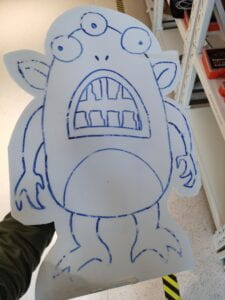
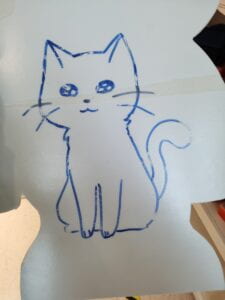
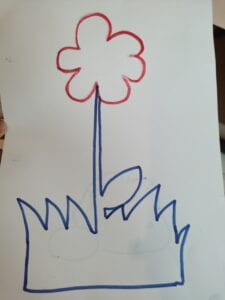
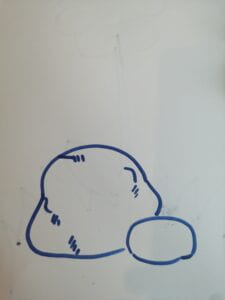
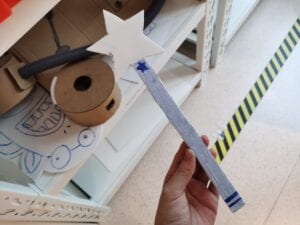
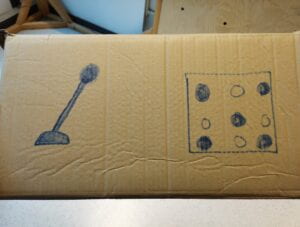
The most difficult part is to connect the two boxes together. We didn’t use string or wire because we tried to make the connection more obvious so we use a pipe instead. As the pipe is a bit too heavy for the box, I made a “lock catch” to connect them and it worked quite well.
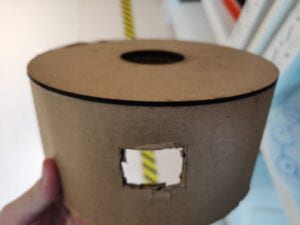
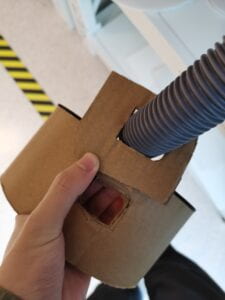
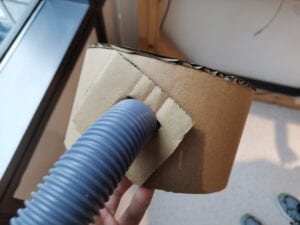
Rehearse and perform:
Since we need to perform during recitation, we tried our best to not only demonstrate the functions of the interactive artifact but also make it more interesting. And that’s why I made many modifications to the original lines and add some funny elements such as the “NYU shanghai student” part and some magic spells after the rehearsal.
I think if we had time for another rehearsal and find some audience for feedback, we can make the functions of the artifact more reasonable, such as revising the “NYU shanghai student” to the doctor or an expert like the professors pointed out.
Video during recitation:
Contributions:
For this group project, I did most of the thinking work.
Below are the contributions I made to the project:
- Introduced my idea of the “dream connection machine” to the group and it was chosen as the main part of the group’s interactive artifact.
- Came up with the idea of the specific function of the interactive artifact and shared my idea of how it should be performed with the group. (the first dream, the second dream, and connecting the two dreams together)
- Thought of the content of the first dream. Proposed the rest with the help and inspiration of the other group members.
- Decided the detailed process of the performance and wrote a basic script. (Came up with the ideas of the magic spells and the monster)
- Took part in the making of the props. My part is to connect the two devices (boxes) together using the pipe.
- Thought about my own character’s lines and gave advice to other group members.
- Added funny elements to the performance during the rehearsal.
- Played the role of the NYU shanghai student in the dream during recitation.
Analysis and assessment of Group 4
Group 4’s project makes the “face to face” interactions between the avatars of yours and your friends possible. It also creatively shows the comparison between the online world and the offline world. I guess the interactive artifact might be related to the fictional story “The fish of Lijiang” where many projection technologies such as the holographic fish are introduced. The performance of each actor is really dedicated and interesting but I think the interactive artifact itself could be more imaginative because similar technologies such as virtual reality and augmented reality used in games have already existed.
During the recitation class, when asked about the differences between video chat and the project, members of the group answered that users can do pretty much anything by using the device. But I doubt its feasibility because in the performance the avatars cannot touch anything which means anything that involves feelings or physical movements such as sports cannot be achieved simply by using that device. That’s why I think more functions that cannot be done in daily lives could be added and more wearable devices with sensors could be put into use to make touching possible even in the virtual world.
Work Cited List
Published by Eric Forman View all posts by Eric Forman, et al. “Pillow Talk: Networking Long-Distance Lovers.” HelloCircuits!, 13 Sept. 2015, hellocircuits.com/2010/05/05/pillow-talk-networking-long-distance-lovers/.
Gibson, William. “The Winter Market”. Vancouver Magazine, 1985.
Free Guy.Dir. Shawn Levy. 20th Century Studios, 2021. Film.
Crawford, Chris. The Art of Interactive Design: A Euphonious and Illuminating Guide to Building Successful Software. No Starch Press, 2003.
